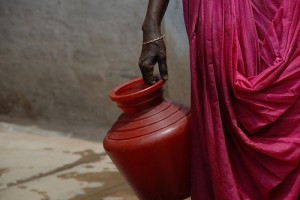Water, Food and 1.2 Billion People
Nov 16th, 2012 | By admin | Category: Climate ChangeBy Suzanne York, www.howmany.org
Mention India and many contradictory images are often conjured up – poverty and Rajput castles, rich and exotic foods and begging mothers and children, the Himalayan mountains and Rajasthani deserts.
But there is no contradiction on the importance of the Indian monsoon. Indian agriculture and much of Indian culture are intertwined with the seasonal rains. And the future outlook on the reliability of monsoons does not look promising.
The monsoon months of June to September bring three-quarters of India’s annual rainfall. Yet alarmingly, more experts are predicting that due to climate change, the coming decades will bring erratic monsoon seasons in South Asia. This is bad news for Indian farmers, especially rural farmer communities. It is also bad news for food and water security in a country destined to be the world’s most populous by 2030.
A study in the journal Environmental Research Letters from researchers at Potsdam Institute for Climate Impact Research in Germany found that the monsoons are likely to be 40-70 percent below normal levels and fail more often over the next two centuries. And between 2150 and 2200, the study predicts the monsoons could fail every 5 years.
Specifically, the study’s authors found that rising temperatures and a change in strength of a Pacific Ocean circulation pattern known as the Pacific Walker circulation in spring could cause more frequent and severe changes in monsoon rains.
In 2009 monsoon rains were 22 percent below average and Indians faced widespread drought. The country had to import large amounts of sugar, pushing global prices to 30-year highs.
India is a predominantly rural country, with over 600 million of its 1.2 billion citizens relying directly on agriculture. Nearly two-thirds of Indian fields are fed only by rain.
Krishna Kumar Kanikicharla, a scientist with the Indian Institute of Tropical Meteorology, told the Yale University blog Environment360 that in a country where more than half of the population works in agriculture, “Livelihoods, water security, and energy security are all tied to volume and timely arrival of monsoon season.”
Women will feel the brunt of changes to the monsoon the most. In India, nearly eighty percent of women work in agriculture (mainly as smallholder, rural farmers) and will have to cope with droughts, floods, and erratic rains.
Adding to the water scarcity concern is the status of aquifers, a heavily relied upon source of water in India that is at risk. The groundwater is being pumped primarily for irrigating agricultural lands and as a source of drinking water; aquifers are being depleted faster than can be replenished by nature.
The past 200 years of ever increasing reliance on fossil fuels is altering the climate in ways yet unknown. The pattern is not likely to change unless the world commits to renewable, alternative energy sources and less carbon intensive solutions. So much already exists and only needs the will of governments to push new energy policies forward.
The time to act is now. The International Energy Agency just issued its annual World Energy Outlook 2012 report that states the world is failing to move towards a more sustainable path for energy, as it continues its addiction to fossil fuels in the face of climate change and growing water scarcity.
There are organizations in India working to empower communities – especially women – via small-scale and organic farming methods, as well as traditional measures to cope with droughts. One example is the Green Foundation, a grassroots organization that works to empower south Indian women to build resilient communities in the face of climate change and sustain rural livelihoods without damaging the ecosystem.
Another example is GRAVIS, based in the state of Rajasthan. The organization promotes sustainable rural development via capacity building, community and women’s empowerment, social justice, and protecting the environment. GRAVIS empowers rural desert communities via a traditional source of water storage, called taankas.
The consequences for continuing business as usual are great. In 2012 the monsoon came late, threatening the livelihoods of millions of people. Imagine if it doesn’t come at all. The effects of an erratic monsoon season would be felt beyond India of course, from creating climate refugees to a decline in tea production to threatened global security. Empowering communities and implementing local efforts are a key part of the solution. The overall solution though, is reducing global fossil fuel usage and emissions, which is the challenge facing the whole world.
Suzanne York is a senior writer with the Institute for Population Studies
Photo credit: http://www.flickr.com/photos/waterdotorg/3695973907/in/photostream/

